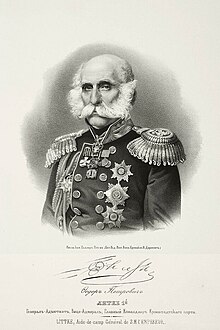Friedrich Benjamin von Lütke
This article needs additional citations for verification. (January 2020) |




Friedrich Benjamin Graf
Biography
This section needs additional citations for verification. (August 2022) |
Friedrich came from the Lütke family (ru) of Brandenburgish origin and originated in Jüterbog. Count Lütke's grandfather was Johann Philipp von Lütke, a German Lutheran preacher and writer on physical science and theology. In 1745, Johann went from Germany to Moscow as pastor of a Lutheran parish in order to spread Lutheranism in the Russian Empire. As a youth, Friedrich attended a Lutheran German-speaking school. He remained a practicing Lutheran.[citation needed]
Lütke started his naval career in the
During this voyage he described the western coastline of the Bering Sea, the Bonin Islands off Japan, and the Carolines, although he discovered only one new island (Eauripik, the expedition is noted for having visited every inhabited island in the Caroline Islands (with the exception of Yap) and for compiling an extensive ethnographic account. In particular, the expedition spent three weeks in the Nomoi Islands, which had been last visited by Pedro Quiros in 1565. The team collected over 8000 plant, animal and mineral samples.[2]
In 1835, Lütke was appointed by Tsar
In 1873, the Russian Geographical Society introduced the Lütke gold medal. A cape, peninsula, mountain and bay in Novaya Zemlya, as well as a group of islands in Franz Josef Land, Baydaratskaya Bay, and the Nordenskiöld Archipelago and a strait between Kamchatka and Karaginsky Island, as well as two Russian icebreakers were named after him.[citation needed]
Ships named after Lütke include 1909-built icebreaker, 1970-built icebreaker, and 2017-built Yamalmax LNG carrier.
Lütke's contribution to the geography of Alaska
During his voyage round the world on the Russian
After finally returning to Kronstadt Litke published a 3-volume account of his explorations with atlases in Russian and in French, the latter being published in Paris and entitled Voyage autour du monde, : exécuté par ordre de sa majesté l’empereur Nicolas Ier, sur la corvette Le Séniavine, dans les années 1826, 1827, 1828 et 1829, par Frédéric Lutké, ... commandant de l’expédition. Partie historique, avec un atlas, litographié d’après les dessins originaux d’Alexandre Postels et du baron Kittlitz. Traduit du russe sur le manuscrit original, sous les yeux de l’auteur, par le conseiller d’état F. Boyé. Tome I–III. Very few copies were printed and especially the Russian original work with its nautical part became an extremely rare item.
The nautical volume contains hydrographic and geographic details on the then little-known Bering Sea and
Certain geographic features of the Alaskan coast, like the

In the stamps
-
USSR, 1947
-
Count Lütke's portrait on a 1947 Soviet postage stamp in a series issued to commemorate the centennial of the Russian Geographical Society.
-
Postage stamp of the USSR, 1976: Fyodor Litke (1909 icebreaker)
-
F. P. Litke on a Russian postage stamp, 1994
See also
References
- ^ Regarding personal names: Until 1919, Graf was a title, translated as Count, not a first or middle name. The female form is Gräfin. In Germany, it has formed part of family names since 1919.
- ^ ISBN 0810853957.
- Andreas W. Daum: German Naturalists in the Pacific around 1800: Entanglement, Autonomy, and a Transnational Culture of Expertise. In: Explorations and Entanglements: Germans in Pacific Worlds from the Early Modern Period to World War I, ed. Hartmut Berghoff et al. New York, Berghahn Books, 2019, pp. 70‒102.
- ^ Marine Algae of California
- ^ von Klingspor 1882, p. 67.
- ^ The Naming of Alaska — Explorers 'L' — ExploreNorth
- ^ "Feature Detail Report for: Cape Lutke". Geographic Names Information System. United States Geological Survey, United States Department of the Interior.
External links
 Media related to Fyodor Petrovich Litke at Wikimedia Commons
Media related to Fyodor Petrovich Litke at Wikimedia Commons- Obituary: Proceedings of the Royal Geographical Society and Monthly Record of Geography
Sources
- von Klingspor, Carl Arvid, ed. (1882). "Baltisches Wappenbuch : Wappen sämmtlicher der Ritterschaften von Livland, Estland, Kurland und Oesel zugehöriger Adelsgeschlechter | DIGAR" [Baltic heraldic coat of arms all, belonging to the knighthoods of Livonia, Estonia, Courland and Oesel noble families]. www.digar.ee (in Estonian). F & G Beijer.




